Case Study: Nike's ERP Implementation Challenges and Successes
VerifiedAdded on 2022/09/09
|9
|1858
|20
Case Study
AI Summary
This case study examines Nike's ERP implementation, analyzing the challenges faced during the demand planning system implementation and the subsequent success of the ERP project. The study highlights the importance of Organization Project Management (OPM) in aligning project management with organizational strategy and goals. It discusses the reasons for the failure of the demand planning system, including issues with legacy data, lack of unified project management, and inadequate end-user training. The analysis then contrasts this with the successful ERP implementation, attributing its success to planned project implementation, comprehensive end-user training, and effective use of business process reengineering. The case study emphasizes the advantages of a phased rollout approach, enabling gradual system adoption and efficient data transfer. Overall, the document offers valuable insights into the critical success factors for ERP implementation and the importance of learning from past mistakes.

Running head: NIKE
Enterprises Resource Planning: Case Study of Nike
Name of Student
Name of University
Author Note
Enterprises Resource Planning: Case Study of Nike
Name of Student
Name of University
Author Note
Paraphrase This Document
Need a fresh take? Get an instant paraphrase of this document with our AI Paraphraser
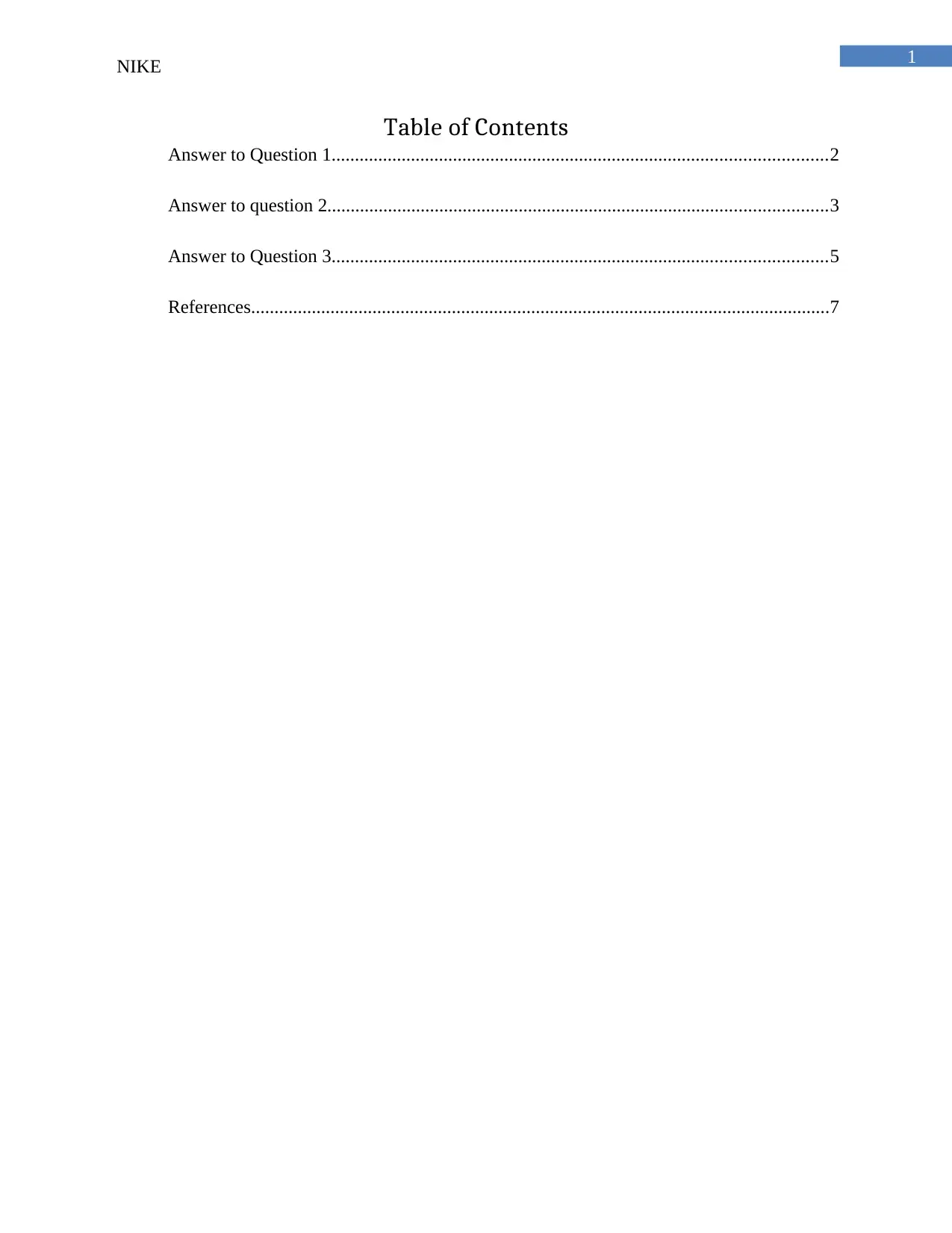
1
NIKE
Table of Contents
Answer to Question 1..........................................................................................................2
Answer to question 2...........................................................................................................3
Answer to Question 3..........................................................................................................5
References............................................................................................................................7
NIKE
Table of Contents
Answer to Question 1..........................................................................................................2
Answer to question 2...........................................................................................................3
Answer to Question 3..........................................................................................................5
References............................................................................................................................7
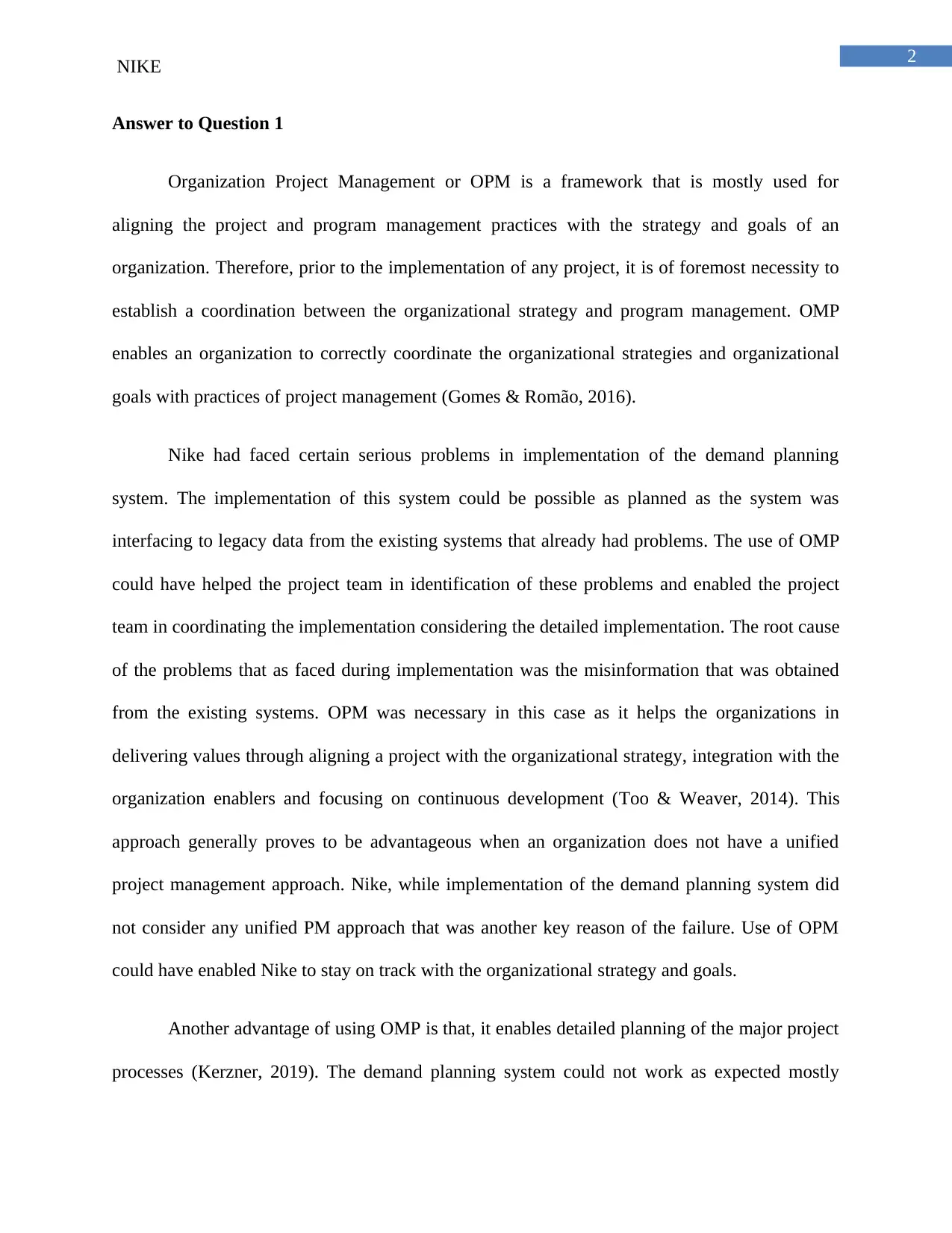
2
NIKE
Answer to Question 1
Organization Project Management or OPM is a framework that is mostly used for
aligning the project and program management practices with the strategy and goals of an
organization. Therefore, prior to the implementation of any project, it is of foremost necessity to
establish a coordination between the organizational strategy and program management. OMP
enables an organization to correctly coordinate the organizational strategies and organizational
goals with practices of project management (Gomes & Romão, 2016).
Nike had faced certain serious problems in implementation of the demand planning
system. The implementation of this system could be possible as planned as the system was
interfacing to legacy data from the existing systems that already had problems. The use of OMP
could have helped the project team in identification of these problems and enabled the project
team in coordinating the implementation considering the detailed implementation. The root cause
of the problems that as faced during implementation was the misinformation that was obtained
from the existing systems. OPM was necessary in this case as it helps the organizations in
delivering values through aligning a project with the organizational strategy, integration with the
organization enablers and focusing on continuous development (Too & Weaver, 2014). This
approach generally proves to be advantageous when an organization does not have a unified
project management approach. Nike, while implementation of the demand planning system did
not consider any unified PM approach that was another key reason of the failure. Use of OPM
could have enabled Nike to stay on track with the organizational strategy and goals.
Another advantage of using OMP is that, it enables detailed planning of the major project
processes (Kerzner, 2019). The demand planning system could not work as expected mostly
NIKE
Answer to Question 1
Organization Project Management or OPM is a framework that is mostly used for
aligning the project and program management practices with the strategy and goals of an
organization. Therefore, prior to the implementation of any project, it is of foremost necessity to
establish a coordination between the organizational strategy and program management. OMP
enables an organization to correctly coordinate the organizational strategies and organizational
goals with practices of project management (Gomes & Romão, 2016).
Nike had faced certain serious problems in implementation of the demand planning
system. The implementation of this system could be possible as planned as the system was
interfacing to legacy data from the existing systems that already had problems. The use of OMP
could have helped the project team in identification of these problems and enabled the project
team in coordinating the implementation considering the detailed implementation. The root cause
of the problems that as faced during implementation was the misinformation that was obtained
from the existing systems. OPM was necessary in this case as it helps the organizations in
delivering values through aligning a project with the organizational strategy, integration with the
organization enablers and focusing on continuous development (Too & Weaver, 2014). This
approach generally proves to be advantageous when an organization does not have a unified
project management approach. Nike, while implementation of the demand planning system did
not consider any unified PM approach that was another key reason of the failure. Use of OPM
could have enabled Nike to stay on track with the organizational strategy and goals.
Another advantage of using OMP is that, it enables detailed planning of the major project
processes (Kerzner, 2019). The demand planning system could not work as expected mostly
⊘ This is a preview!⊘
Do you want full access?
Subscribe today to unlock all pages.

Trusted by 1+ million students worldwide
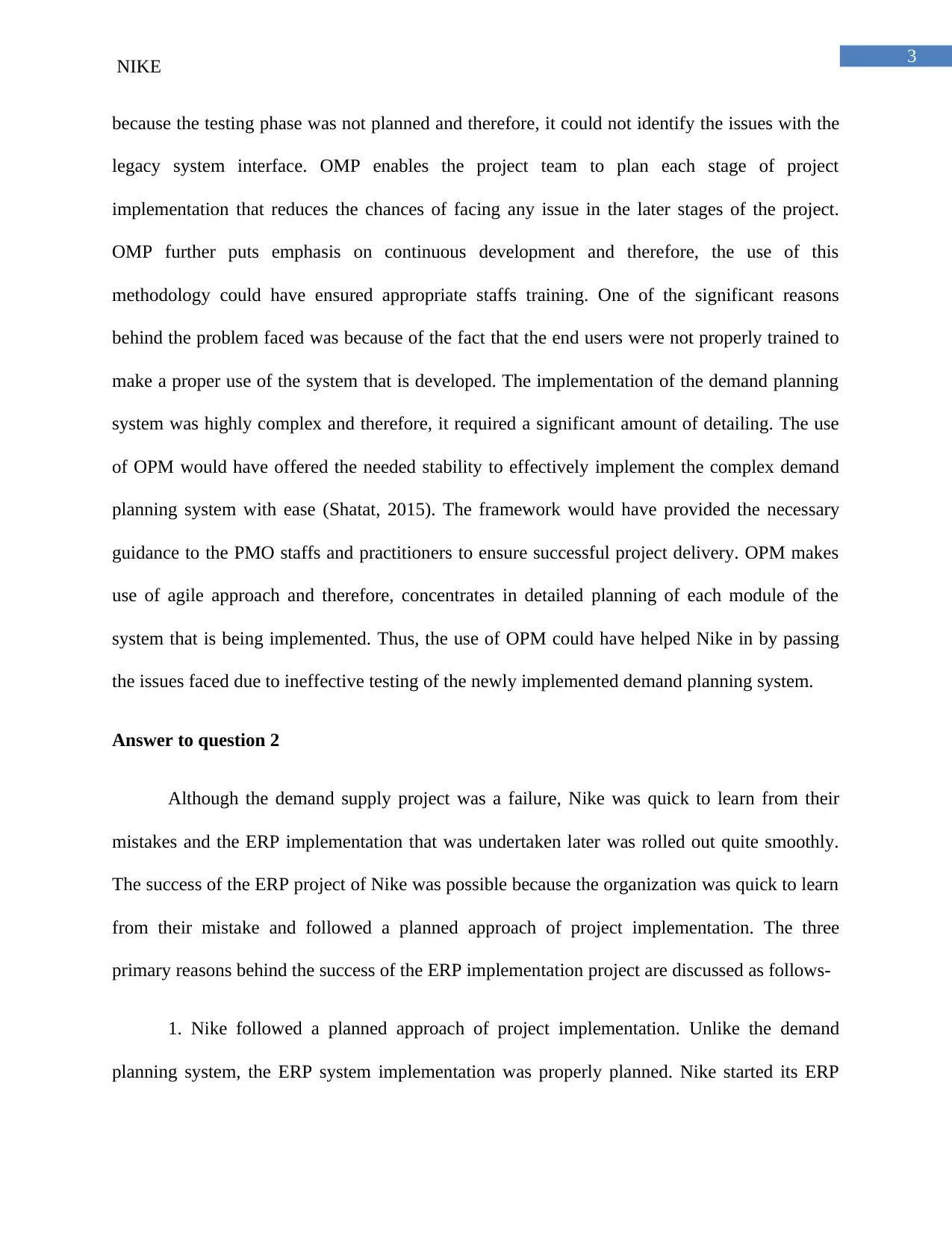
3
NIKE
because the testing phase was not planned and therefore, it could not identify the issues with the
legacy system interface. OMP enables the project team to plan each stage of project
implementation that reduces the chances of facing any issue in the later stages of the project.
OMP further puts emphasis on continuous development and therefore, the use of this
methodology could have ensured appropriate staffs training. One of the significant reasons
behind the problem faced was because of the fact that the end users were not properly trained to
make a proper use of the system that is developed. The implementation of the demand planning
system was highly complex and therefore, it required a significant amount of detailing. The use
of OPM would have offered the needed stability to effectively implement the complex demand
planning system with ease (Shatat, 2015). The framework would have provided the necessary
guidance to the PMO staffs and practitioners to ensure successful project delivery. OPM makes
use of agile approach and therefore, concentrates in detailed planning of each module of the
system that is being implemented. Thus, the use of OPM could have helped Nike in by passing
the issues faced due to ineffective testing of the newly implemented demand planning system.
Answer to question 2
Although the demand supply project was a failure, Nike was quick to learn from their
mistakes and the ERP implementation that was undertaken later was rolled out quite smoothly.
The success of the ERP project of Nike was possible because the organization was quick to learn
from their mistake and followed a planned approach of project implementation. The three
primary reasons behind the success of the ERP implementation project are discussed as follows-
1. Nike followed a planned approach of project implementation. Unlike the demand
planning system, the ERP system implementation was properly planned. Nike started its ERP
NIKE
because the testing phase was not planned and therefore, it could not identify the issues with the
legacy system interface. OMP enables the project team to plan each stage of project
implementation that reduces the chances of facing any issue in the later stages of the project.
OMP further puts emphasis on continuous development and therefore, the use of this
methodology could have ensured appropriate staffs training. One of the significant reasons
behind the problem faced was because of the fact that the end users were not properly trained to
make a proper use of the system that is developed. The implementation of the demand planning
system was highly complex and therefore, it required a significant amount of detailing. The use
of OPM would have offered the needed stability to effectively implement the complex demand
planning system with ease (Shatat, 2015). The framework would have provided the necessary
guidance to the PMO staffs and practitioners to ensure successful project delivery. OPM makes
use of agile approach and therefore, concentrates in detailed planning of each module of the
system that is being implemented. Thus, the use of OPM could have helped Nike in by passing
the issues faced due to ineffective testing of the newly implemented demand planning system.
Answer to question 2
Although the demand supply project was a failure, Nike was quick to learn from their
mistakes and the ERP implementation that was undertaken later was rolled out quite smoothly.
The success of the ERP project of Nike was possible because the organization was quick to learn
from their mistake and followed a planned approach of project implementation. The three
primary reasons behind the success of the ERP implementation project are discussed as follows-
1. Nike followed a planned approach of project implementation. Unlike the demand
planning system, the ERP system implementation was properly planned. Nike started its ERP
Paraphrase This Document
Need a fresh take? Get an instant paraphrase of this document with our AI Paraphraser
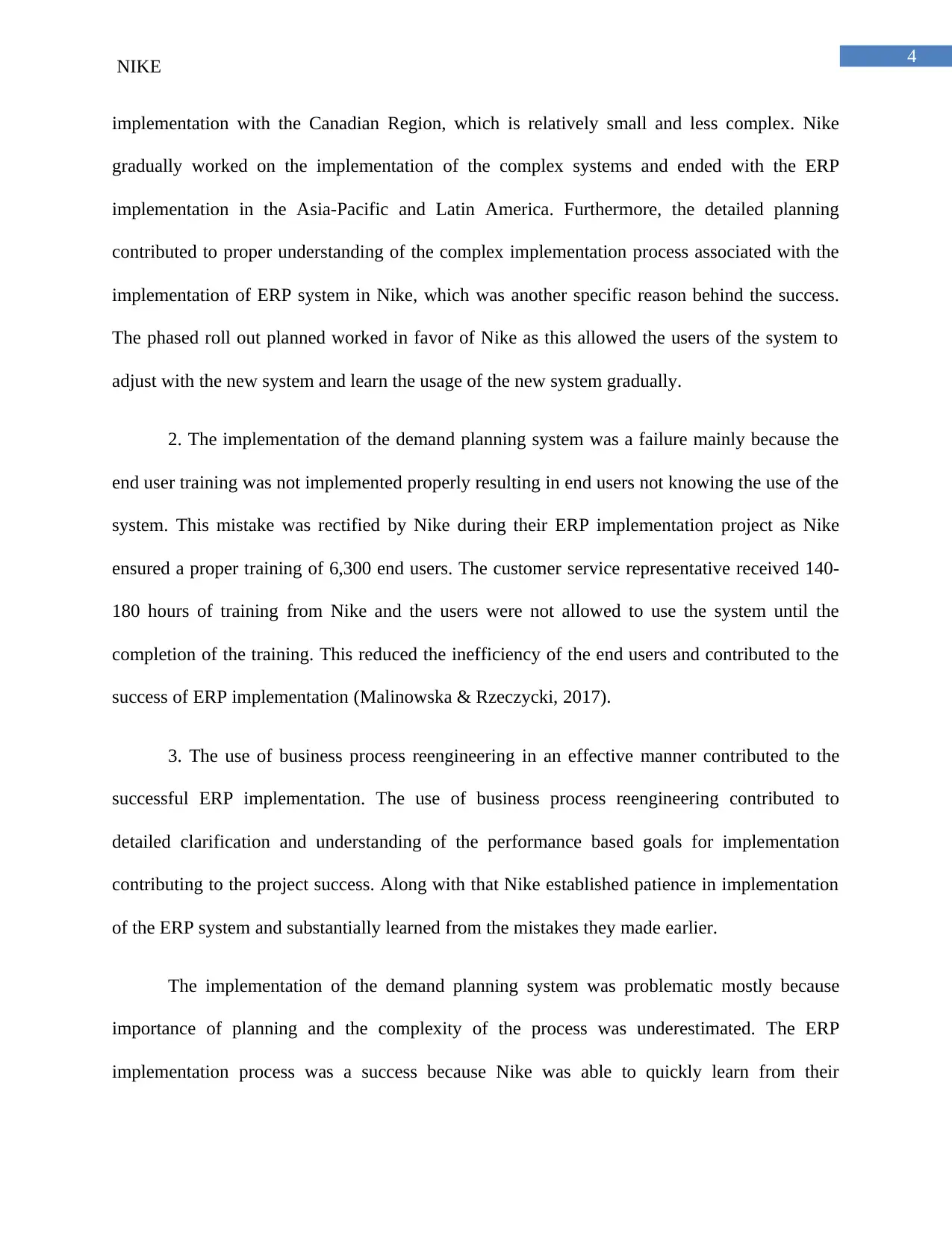
4
NIKE
implementation with the Canadian Region, which is relatively small and less complex. Nike
gradually worked on the implementation of the complex systems and ended with the ERP
implementation in the Asia-Pacific and Latin America. Furthermore, the detailed planning
contributed to proper understanding of the complex implementation process associated with the
implementation of ERP system in Nike, which was another specific reason behind the success.
The phased roll out planned worked in favor of Nike as this allowed the users of the system to
adjust with the new system and learn the usage of the new system gradually.
2. The implementation of the demand planning system was a failure mainly because the
end user training was not implemented properly resulting in end users not knowing the use of the
system. This mistake was rectified by Nike during their ERP implementation project as Nike
ensured a proper training of 6,300 end users. The customer service representative received 140-
180 hours of training from Nike and the users were not allowed to use the system until the
completion of the training. This reduced the inefficiency of the end users and contributed to the
success of ERP implementation (Malinowska & Rzeczycki, 2017).
3. The use of business process reengineering in an effective manner contributed to the
successful ERP implementation. The use of business process reengineering contributed to
detailed clarification and understanding of the performance based goals for implementation
contributing to the project success. Along with that Nike established patience in implementation
of the ERP system and substantially learned from the mistakes they made earlier.
The implementation of the demand planning system was problematic mostly because
importance of planning and the complexity of the process was underestimated. The ERP
implementation process was a success because Nike was able to quickly learn from their
NIKE
implementation with the Canadian Region, which is relatively small and less complex. Nike
gradually worked on the implementation of the complex systems and ended with the ERP
implementation in the Asia-Pacific and Latin America. Furthermore, the detailed planning
contributed to proper understanding of the complex implementation process associated with the
implementation of ERP system in Nike, which was another specific reason behind the success.
The phased roll out planned worked in favor of Nike as this allowed the users of the system to
adjust with the new system and learn the usage of the new system gradually.
2. The implementation of the demand planning system was a failure mainly because the
end user training was not implemented properly resulting in end users not knowing the use of the
system. This mistake was rectified by Nike during their ERP implementation project as Nike
ensured a proper training of 6,300 end users. The customer service representative received 140-
180 hours of training from Nike and the users were not allowed to use the system until the
completion of the training. This reduced the inefficiency of the end users and contributed to the
success of ERP implementation (Malinowska & Rzeczycki, 2017).
3. The use of business process reengineering in an effective manner contributed to the
successful ERP implementation. The use of business process reengineering contributed to
detailed clarification and understanding of the performance based goals for implementation
contributing to the project success. Along with that Nike established patience in implementation
of the ERP system and substantially learned from the mistakes they made earlier.
The implementation of the demand planning system was problematic mostly because
importance of planning and the complexity of the process was underestimated. The ERP
implementation process was a success because Nike was able to quickly learn from their
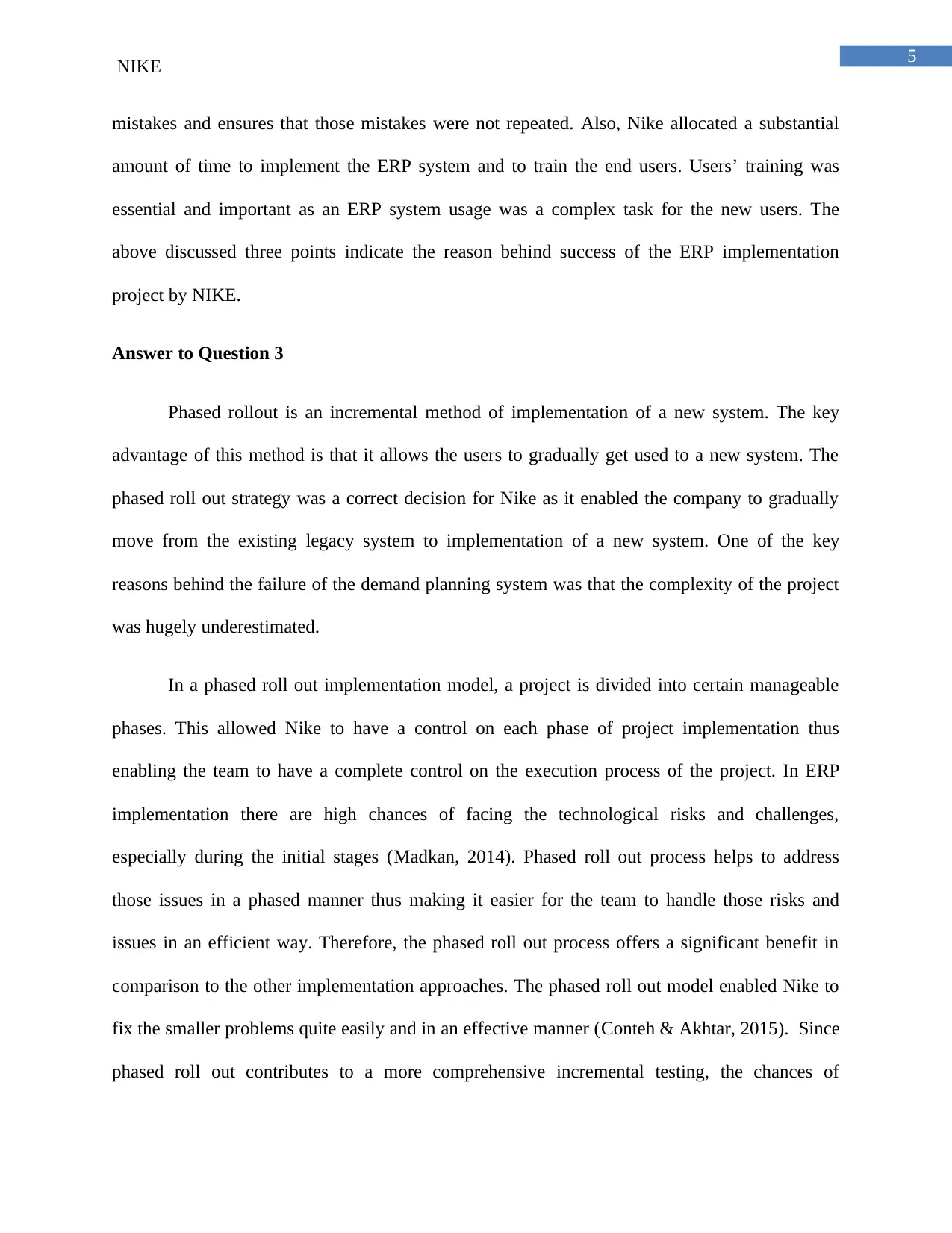
5
NIKE
mistakes and ensures that those mistakes were not repeated. Also, Nike allocated a substantial
amount of time to implement the ERP system and to train the end users. Users’ training was
essential and important as an ERP system usage was a complex task for the new users. The
above discussed three points indicate the reason behind success of the ERP implementation
project by NIKE.
Answer to Question 3
Phased rollout is an incremental method of implementation of a new system. The key
advantage of this method is that it allows the users to gradually get used to a new system. The
phased roll out strategy was a correct decision for Nike as it enabled the company to gradually
move from the existing legacy system to implementation of a new system. One of the key
reasons behind the failure of the demand planning system was that the complexity of the project
was hugely underestimated.
In a phased roll out implementation model, a project is divided into certain manageable
phases. This allowed Nike to have a control on each phase of project implementation thus
enabling the team to have a complete control on the execution process of the project. In ERP
implementation there are high chances of facing the technological risks and challenges,
especially during the initial stages (Madkan, 2014). Phased roll out process helps to address
those issues in a phased manner thus making it easier for the team to handle those risks and
issues in an efficient way. Therefore, the phased roll out process offers a significant benefit in
comparison to the other implementation approaches. The phased roll out model enabled Nike to
fix the smaller problems quite easily and in an effective manner (Conteh & Akhtar, 2015). Since
phased roll out contributes to a more comprehensive incremental testing, the chances of
NIKE
mistakes and ensures that those mistakes were not repeated. Also, Nike allocated a substantial
amount of time to implement the ERP system and to train the end users. Users’ training was
essential and important as an ERP system usage was a complex task for the new users. The
above discussed three points indicate the reason behind success of the ERP implementation
project by NIKE.
Answer to Question 3
Phased rollout is an incremental method of implementation of a new system. The key
advantage of this method is that it allows the users to gradually get used to a new system. The
phased roll out strategy was a correct decision for Nike as it enabled the company to gradually
move from the existing legacy system to implementation of a new system. One of the key
reasons behind the failure of the demand planning system was that the complexity of the project
was hugely underestimated.
In a phased roll out implementation model, a project is divided into certain manageable
phases. This allowed Nike to have a control on each phase of project implementation thus
enabling the team to have a complete control on the execution process of the project. In ERP
implementation there are high chances of facing the technological risks and challenges,
especially during the initial stages (Madkan, 2014). Phased roll out process helps to address
those issues in a phased manner thus making it easier for the team to handle those risks and
issues in an efficient way. Therefore, the phased roll out process offers a significant benefit in
comparison to the other implementation approaches. The phased roll out model enabled Nike to
fix the smaller problems quite easily and in an effective manner (Conteh & Akhtar, 2015). Since
phased roll out contributes to a more comprehensive incremental testing, the chances of
⊘ This is a preview!⊘
Do you want full access?
Subscribe today to unlock all pages.

Trusted by 1+ million students worldwide
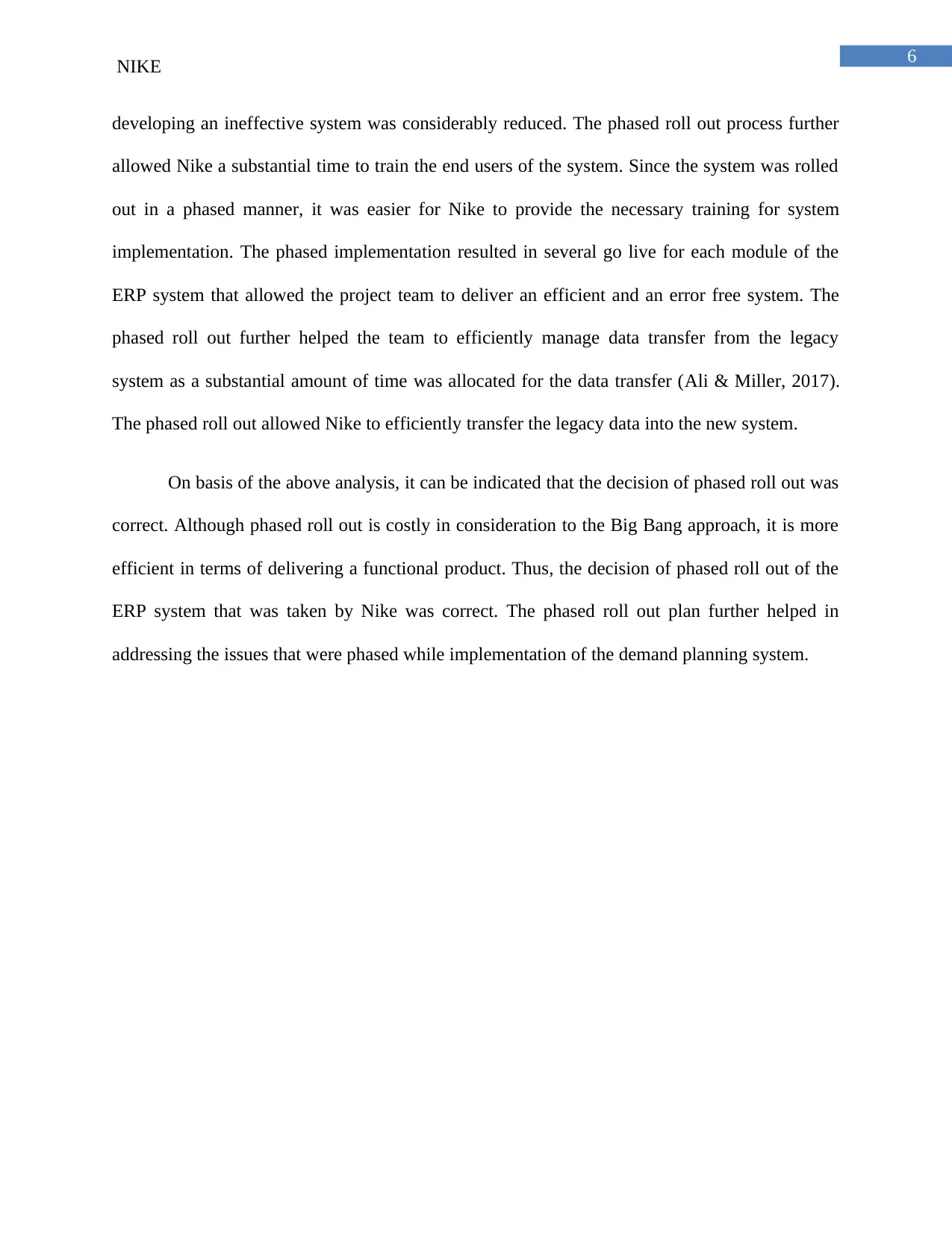
6
NIKE
developing an ineffective system was considerably reduced. The phased roll out process further
allowed Nike a substantial time to train the end users of the system. Since the system was rolled
out in a phased manner, it was easier for Nike to provide the necessary training for system
implementation. The phased implementation resulted in several go live for each module of the
ERP system that allowed the project team to deliver an efficient and an error free system. The
phased roll out further helped the team to efficiently manage data transfer from the legacy
system as a substantial amount of time was allocated for the data transfer (Ali & Miller, 2017).
The phased roll out allowed Nike to efficiently transfer the legacy data into the new system.
On basis of the above analysis, it can be indicated that the decision of phased roll out was
correct. Although phased roll out is costly in consideration to the Big Bang approach, it is more
efficient in terms of delivering a functional product. Thus, the decision of phased roll out of the
ERP system that was taken by Nike was correct. The phased roll out plan further helped in
addressing the issues that were phased while implementation of the demand planning system.
NIKE
developing an ineffective system was considerably reduced. The phased roll out process further
allowed Nike a substantial time to train the end users of the system. Since the system was rolled
out in a phased manner, it was easier for Nike to provide the necessary training for system
implementation. The phased implementation resulted in several go live for each module of the
ERP system that allowed the project team to deliver an efficient and an error free system. The
phased roll out further helped the team to efficiently manage data transfer from the legacy
system as a substantial amount of time was allocated for the data transfer (Ali & Miller, 2017).
The phased roll out allowed Nike to efficiently transfer the legacy data into the new system.
On basis of the above analysis, it can be indicated that the decision of phased roll out was
correct. Although phased roll out is costly in consideration to the Big Bang approach, it is more
efficient in terms of delivering a functional product. Thus, the decision of phased roll out of the
ERP system that was taken by Nike was correct. The phased roll out plan further helped in
addressing the issues that were phased while implementation of the demand planning system.
Paraphrase This Document
Need a fresh take? Get an instant paraphrase of this document with our AI Paraphraser
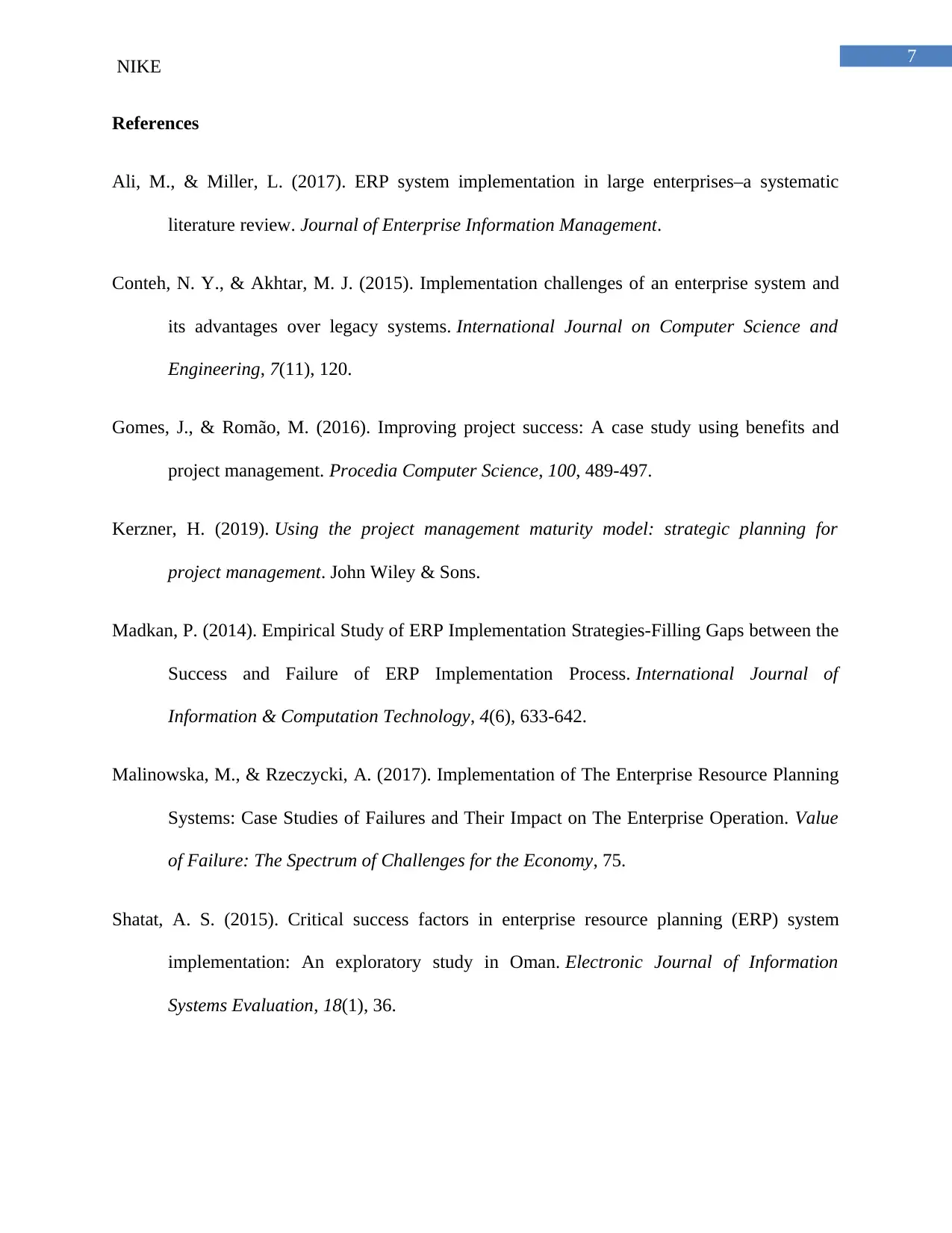
7
NIKE
References
Ali, M., & Miller, L. (2017). ERP system implementation in large enterprises–a systematic
literature review. Journal of Enterprise Information Management.
Conteh, N. Y., & Akhtar, M. J. (2015). Implementation challenges of an enterprise system and
its advantages over legacy systems. International Journal on Computer Science and
Engineering, 7(11), 120.
Gomes, J., & Romão, M. (2016). Improving project success: A case study using benefits and
project management. Procedia Computer Science, 100, 489-497.
Kerzner, H. (2019). Using the project management maturity model: strategic planning for
project management. John Wiley & Sons.
Madkan, P. (2014). Empirical Study of ERP Implementation Strategies-Filling Gaps between the
Success and Failure of ERP Implementation Process. International Journal of
Information & Computation Technology, 4(6), 633-642.
Malinowska, M., & Rzeczycki, A. (2017). Implementation of The Enterprise Resource Planning
Systems: Case Studies of Failures and Their Impact on The Enterprise Operation. Value
of Failure: The Spectrum of Challenges for the Economy, 75.
Shatat, A. S. (2015). Critical success factors in enterprise resource planning (ERP) system
implementation: An exploratory study in Oman. Electronic Journal of Information
Systems Evaluation, 18(1), 36.
NIKE
References
Ali, M., & Miller, L. (2017). ERP system implementation in large enterprises–a systematic
literature review. Journal of Enterprise Information Management.
Conteh, N. Y., & Akhtar, M. J. (2015). Implementation challenges of an enterprise system and
its advantages over legacy systems. International Journal on Computer Science and
Engineering, 7(11), 120.
Gomes, J., & Romão, M. (2016). Improving project success: A case study using benefits and
project management. Procedia Computer Science, 100, 489-497.
Kerzner, H. (2019). Using the project management maturity model: strategic planning for
project management. John Wiley & Sons.
Madkan, P. (2014). Empirical Study of ERP Implementation Strategies-Filling Gaps between the
Success and Failure of ERP Implementation Process. International Journal of
Information & Computation Technology, 4(6), 633-642.
Malinowska, M., & Rzeczycki, A. (2017). Implementation of The Enterprise Resource Planning
Systems: Case Studies of Failures and Their Impact on The Enterprise Operation. Value
of Failure: The Spectrum of Challenges for the Economy, 75.
Shatat, A. S. (2015). Critical success factors in enterprise resource planning (ERP) system
implementation: An exploratory study in Oman. Electronic Journal of Information
Systems Evaluation, 18(1), 36.

8
NIKE
Too, E. G., & Weaver, P. (2014). The management of project management: A conceptual
framework for project governance. International Journal of Project Management, 32(8),
1382-1394.
NIKE
Too, E. G., & Weaver, P. (2014). The management of project management: A conceptual
framework for project governance. International Journal of Project Management, 32(8),
1382-1394.
⊘ This is a preview!⊘
Do you want full access?
Subscribe today to unlock all pages.

Trusted by 1+ million students worldwide
1 out of 9
Related Documents
Your All-in-One AI-Powered Toolkit for Academic Success.
+13062052269
info@desklib.com
Available 24*7 on WhatsApp / Email
![[object Object]](/_next/static/media/star-bottom.7253800d.svg)
Unlock your academic potential
Copyright © 2020–2025 A2Z Services. All Rights Reserved. Developed and managed by ZUCOL.





